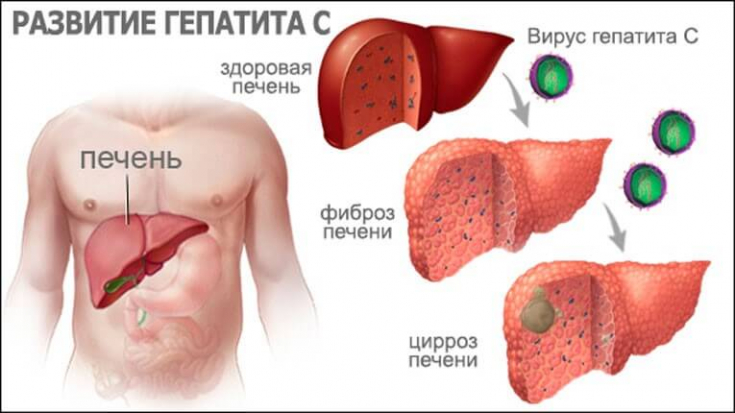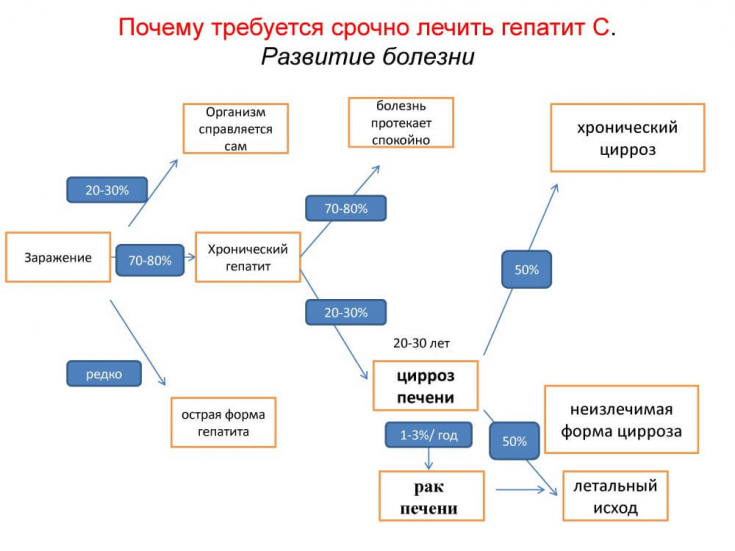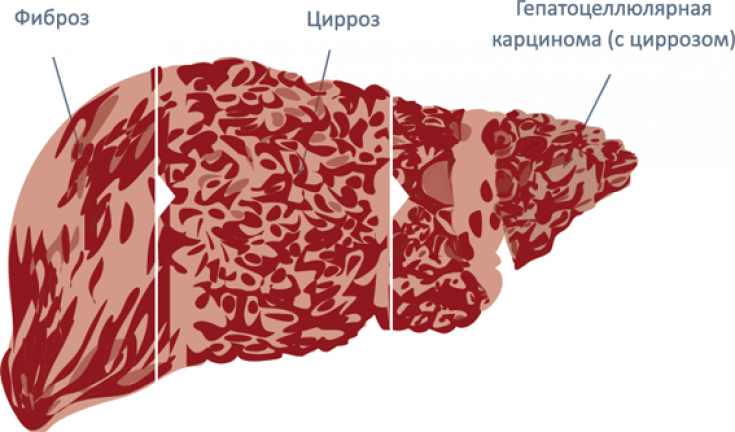Chronic viral hepatitis C (CVHC) − an infectious disease caused by the RNA-containing hepatitis C virus (HCV). According to World Health Organization (WHO), today 71 million people worldwide live with chronic viral hepatitis C. About 1,750,000 new infections caused by HCV are registered annually. After exposure to HCV, 55-85% of people develop a chronic form of viral hepatitis C.
Find out in the article on estet-portal.com how dangerous viral hepatitis C is and what approaches to the treatment of this disease can completely exclude its further development.
- Dangerous consequences of hepatitis C infection
- Modern approaches to the treatment of chronic hepatitis C
- Basic drugs and treatment regimens for viral hepatitis С
Dangerous consequences of hepatitis C infection
In the absence of specific treatment, chronic liver inflammation leads to the progression of fibrosis, the development of cirrhosis of the liver (LC) and hepatocellular carcinoma.
A much worse prognosis is observed with a combination of hepatitis B and C, which is often observed in patients with a chronic course of the disease.
Follow us on Instagram!
Today, there are highly effective schemes antiviral treatment of patients who are ill with chronic viral hepatitis C.
Since viral hepatitis C does not integrate into the human genome, modern therapeutic regimens of antiviral treatment allow achieving complete eradication of the virusa.

Modern approaches to the treatment of chronic hepatitis C
of patients with CHC has the following goals:
Sustained- Virologic Response
- (SVR) − absence of hepatitis C virus RNA as determined by the polymerase chain reaction method after 12 weeks after completion of antiviral therapy. Prevention complications
- : progression of liver cirrhosis, development of hepatocellular carcinoma and decompensated disease requiring liver transplantation. The effectiveness of modern antiviral drugs used to treat patients with chronic viral hepatitis C exceeds 95%.
According toRecommendations
(Infectious Diseases Society of America − IDSA) American Association for the Study of Liver Diseases (American Associations for the Study of Liver Diseases (American Associations for the Study of Liver Diseases − AASLD), all patients require antiviral treatment (except cases where life expectancy cannot be extended with antiviral treatment, liver transplantation, or other etiotropic therapy).
In turn,WHO recommends treatment for all persons with viral hepatitis C aged > 12 years, except pregnant.
Since all patients with hepatitis C cannot be immediately providedantiviral drugs due to their high cost, priority in treatment, according to preliminary recommendations IDSA / AASLD, have patients with:
- severe liver fibrosis;
- compensated liver cirrhosis;
- severe extrahepatic complications;
- liver transplant recipients.
to contactsm.
Acute bronchitis: the effectiveness of drug therapy from the standpoint of evidence-based medicine

Direct-acting antiviral agents (DAAs)
drugs direct-acting antiviral agents (DAAs) affect specific replication targets of viral hepatitis C, inhibiting this stage of the life cycle of the virus: ;NS3/4, NS5A and
combinations of these drugs approved by the Food and Drug Administration.
This results in a sustained virological response (SVR) in 90-95% of cases, in contrast to dual therapypegylated interferon/ribavirin which results in SVR in 50-70% of cases.
Rationale for prescribing probiotics for gastroenteritis
Classification DAAs depending on their mechanism of action and target of HCV replication:
- NS3/4 - protease inhibitors: boceprevir, telaprevir, simeprevir, pratiprevir, grazoprevir, glecaprevir;
- NS5B -polymerase inhibitors: nucleotide inhibitors (sofosbuvir), non-nucleoside inhibitors (dasabuvir);
- NS5A -replication complex inhibitors: ledipasvir, daclatasvir, ombitasvir, elbasvir, velpatasvir, pibrentasvir .

antiviral regimens based on DAAs is the treatment of choice for patients with chronic viral hepatitis C and is characterized by high therapeutic efficacy.
At the same time, antiviral treatment regimens for patients with CHC are veryexpensive.
Recommendations for diagnosis and treatment are regularly updated, and therefore, specialists are advised to follow up-to-date information onmanagement of hepatitis C AASLD and ISDA.
More useful information on our YouTube channel:







Add a comment